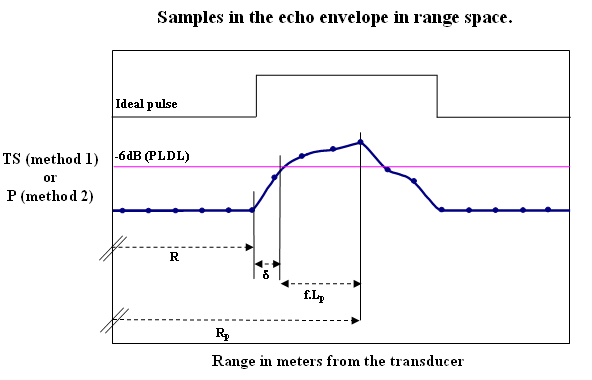Principles of TVG range correction for Single targets
Estimation of target range R and the single target echo envelope

Figure 1. Estimation of target range R. All times are measured from the start of the transmit pulse.
(Redrawn from Fig. 2.17 and Fig. 3.32 Simmonds and MacLennan 2005)
Where:
|
tr
|
= | Receive time (s) of the target echo. t r = th - tdel |
|
th
|
= | Time (s) measured from start of the transmit pulse to the half amplitude point on the echo envelope. This is the recommended procedure+. |
|
tdel |
= | Small time delay (s) due to the receiver electronics. |
|
c
|
= | Speed of sound (m/s) in the medium. |
|
R
|
= | Range in (m) to the target R = c t r /2 R = c (th - tdel)/2 |
From Figure 1, the range from the echosounder to the target is R meters. R is calculated in terms of the echo envelope detection times and the speed of sound.
Time Varied Gain (TVG) applied to the echo should be calculated for a range of R meters. TVG compensates for energy losses in the echo, due to spreading and absorption through the transmission medium.
Target strength (TS) and range in the echo envelope

Figure 2. Example of TS sample data from a single target.
Where:
| = | range equivalent of tdel (delay due to receiver electronics) defined in Figure 1. δ = c tdel/2 |
|
|
c
|
= | Speed of sound (m/s) in the medium. |
|
τ
|
= | Duration (s) of the transmitted pulse. |
|
Lp
|
= | Pulse length (m) in range space. Lp = c τ /2 |
|
f
|
= | Fraction of Lp. f Lp is the distance between the range of the Peak TS and the range of the PLDL intersection with the echo. |
|
PLDL |
= | Pulse length determination level in Echoview. Also known as the -6dB power point. PLDL = 6dB down from the Peak TS. |
|
Rp
|
= | Range (m) of the TS peak sample. |
The target at range R has a peak TS in the echo envelope detected at R+ δ + f.Lp.
Both the TS peak position and the TVG range can be corrected to R by subtracting δ + f.Lp from the range of the peak sample.
If the echo is symmetric, then f = 0.5 and consequently δ + cτ/4 is subtracted from the range of the peak sample.
Echoview Single Target Detection method 1
- Assumes that appropriate TVG range corrections for the data are applied to the TS data prior to the detection of single targets.
- Estimates that the range to the target is at the first sample with a range greater than the PLDL of the echo envelope.
- In most cases this will not equal the range of the TVG compensation applied to the peak.
Note: For some data, Echoview can not determine if appropriate range corrections have been applied to the TS data prior to the detection of single targets. Refer to Are my TS data affected? for more detail.
Echoview Single Target Detection method 2
- Removes applied TVG prior to detecting the echo amplitude peak. This is valid to the first order because all samples within an echo from a single target come from the same range.
- Estimates that the range to the target is the range of the echo peak minus cτ/4, assuming δ is zero.
- Sets the range of the target equal to the range of the TVG compensation.
Method 2 may be applied to data from all manufacturers. If a TVG range correction has been applied to the TS data then this must be specified on the Method 2 Calibration page so that TVG can be correctly removed prior to peak detection.
Echoview Single Target detection algorithms
Further discussion and details about the single target algorithms available in Echoview can be found in the Echoview help file on the Single targets detection algorithms page.
To open the Echoview help file from the Echoview, click the Help menu and select Contents.
Alternatively, use an internet browser to view the on line Echoview help file under Support > Help File at https://echoview.com/.
Return to TVG range correction overview
See also